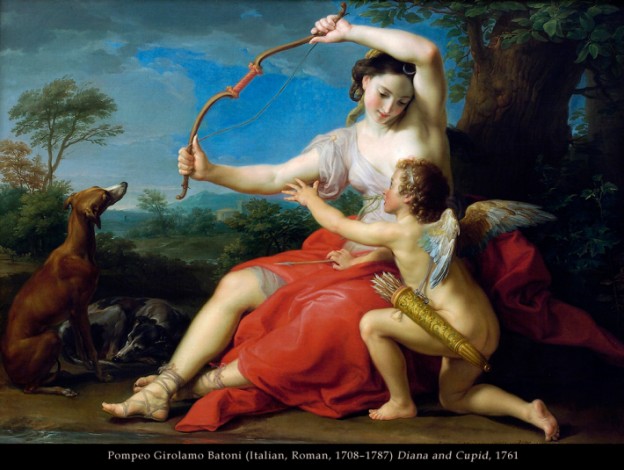Shakespeare juxtaposes loving desire and chaste austerity through the two deities Cupid and Diana. Cupid is “said to be a child” (I.1.238), “blind[ly]” (I.1.235) slinging fiery shafts at maidens to implant tenacious and sometimes self-destructive “fancies.” In contrast, Diana, the “reputedly hostile to men” [1] “virgin goddess of the moon” (MSND, 6), is presented as the antithesis to this amorous frenzy. This relationship is illustrated in Pompeo Batoni’s Diana and Cupid, painted in 1761, which portrays Diana keeping Cupid’s box from him in an authoritative and almost maternal manner. The painting interprets Cupid and Diana’s relationship in a similar way to how Shakespeare approaches it in A Midsummer Night’s Dream. Cupid and Diana are most distinctly juxtaposed through the herbs, loaded with powerful juice and mythological connotations, that Oberon and Puck use to control “fancies.” The pansy flower, or “love-in-idleness,” causes its recipient to “madly dote” (II.1.171). The name pansy, deriving from French pensée, implies a “capacity to produce dreams, illusions, even madness” (McDonald, xlii). The pansy’s herbal antidote, “Dian’s bud,” is a moniker for the plant Agnus Castus, which is also known as “chasteberry” because “the ancients believed [it] decreased one’s libido keeping one chaste.”[2] Just as the effect of “Dian’s bud” is antipodal to Cupid’s pansy, Diana’s influence on love and desire is the opposite of Cupid’s.
Because a “happy ending” in dramatic comedy is defined as “the satisfaction of desire” (McDonald, xxxiv), the audience is lead to root for the fulfillment of characters’ “wants despite mighty obstacles” (McDonald, xxxix). This structure establishes love and lust as heroes, and deterrents to desire as antagonists; consequently, the playwright manipulates the audience to endorse Cupid and resent Diana. The male characters allude to Diana, and the moon as an extension of her, as a cold, un-feminine obstacle to love and happiness. Theseus, anticipating his wedding night, complains, “How slow this old moon wanes! She lingers my desires, like a…dowager long withering out a young man’s revenue” (I.1.4-6). Theseus resents “the moon,” Diana, for stalling his sexual satisfaction, and condescendingly compares her to a spiteful old woman getting in the way of a man’s rightful prize. Similarly, when Hermia refuses to “fit [her] fancies to [her] father’s will” (I.1.118), Theseus gives her a choice between the death penalty, or “to live a barren sister all your life, chanting faint hymns to the cold fruitless moon” (I.1.72-73). Theseus’s verdict reveals that men perceive a woman devoting herself to abstinence on “Diana’s altar” (I.1.89) as equivalent to death, thus defining the sole reason for female existence to be producing children for their husbands.
If we stop the analysis there, the comedic play appears to be horribly misogynistic. However, Shakespeare weaves in a level of sympathy for Diana, and to the seemingly clear-cut good and bad dichotomy between love and prohibition. He includes subtle moments where Diana is a loving, protective deity aiding women’s happiness. In Oberon’s story of the pansy, Cupid tries to “pierce” his “fiery shaft” through a “fair vestal,” but the arrow is “quenched in the chaste beams of the wat’ry moon,” a metaphor for Diana, before it can penetrate the maiden, and she continues on “fancy-free” (II.1.158-164). Later, when Titania is about to have sex with the “beast,” Bottom, she pauses for a moment, distracted by the moon: “The moon methinks looks with a watery eye…she weeps…Lamenting some enforcèd [i.e. violated by force] chastity” (III.2.192-194). In this scene, perhaps Diana, in the form of a “weeping moon,” is trying to warn Titania that she is about to be taken advantage of because of Cupid’s spell, or at least spark her intuition that something is not right about this union. Alas, the pansy is too strong, and Titania follows through with the act. Regardless of the neat wrap-up of the play with all the lovers happily together, Shakespeare adds a subtle level of complexity to the axiom that love should conquer all. Perhaps Diana is the benevolent force here, and following irrational and overwhelming feelings of love is not always the right answer.
[1] Findlay, Alison. Women in Shakespeare. London: Bloomsbury, 2014. Print.
[2] Webster, Donna E. Botanical, Chemical, Genetic, and Pharmacological Studies of Vitex Agnus-castus. N.p.: U of Illinois at Chicago, 2008. Print. 12.
Image: http://www.metmuseum.org/collection/the-collection-online/search/435622

